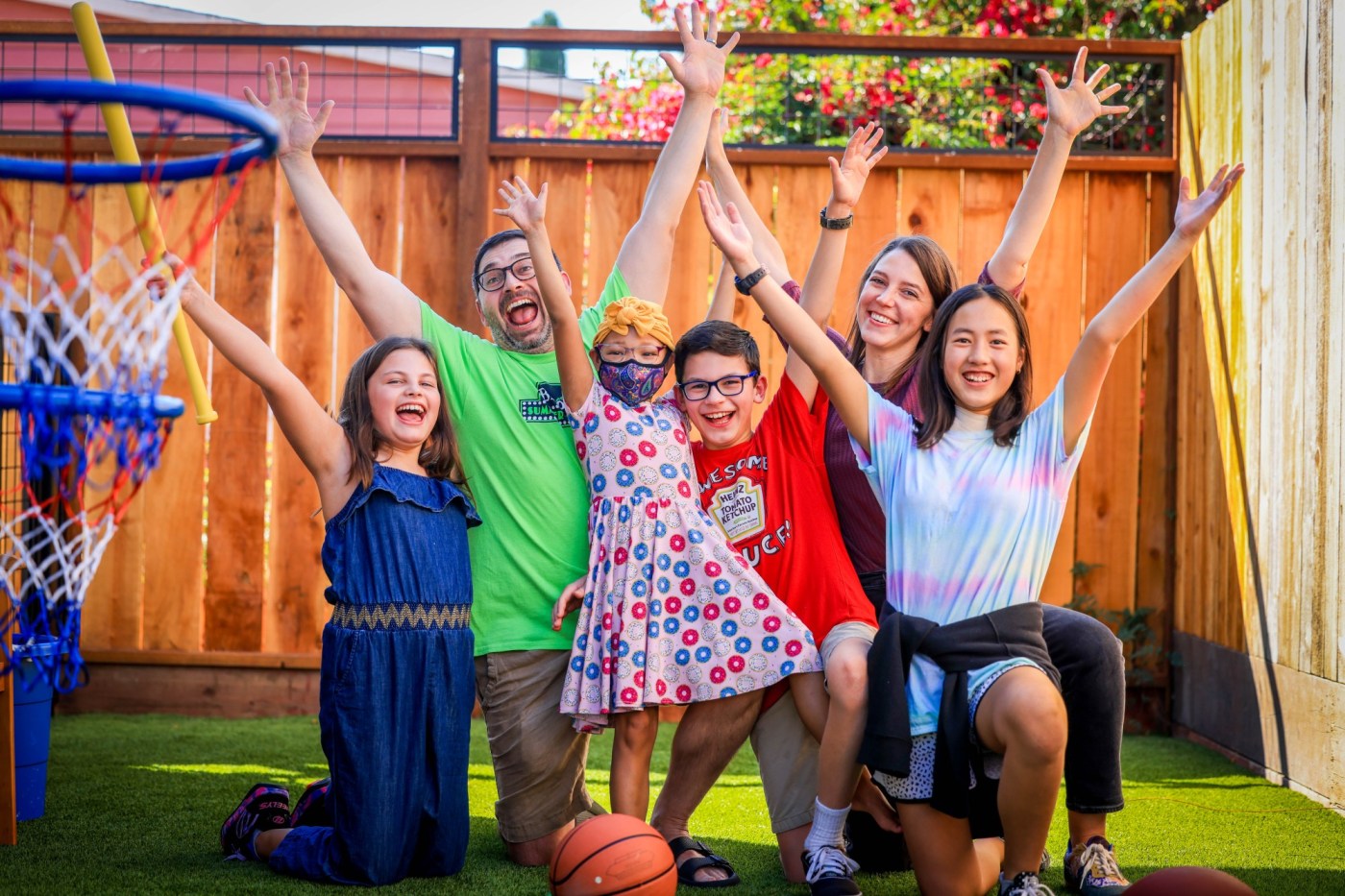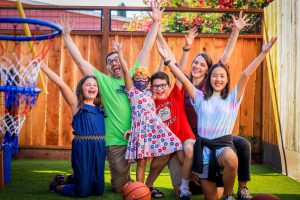
A pioneering gene therapy aims to free patients of blood disease. Is a cure at hand?
Faith in God called Clint and Alissa Finlayson to adopt two sick girls from an orphanage in China. Faith in medicine called them to Oakland.
Born with a deadly blood disease, the Finlayson’s daughters — Ada, 9, and Lily, 12 — are the first patients on the West Coast to receive a new gene therapy offered by UCSF Benioff Children’s Hospital Oakland.
Already, Ada is already feeling better 10 weeks after receiving her stem cell transplant. Lily started treatment last week. Both have 90% chance of a permanent cure.
“It’s science, and it’s a miracle,” said their mother Alissa, sitting in the small yard of their guest home in downtown Oakland, far from their small mountain town of Kalispell, Montana.
Alissa Finlayson, left, along with her daughters Lily, 12,, Ruby, 10, and Ada, 9, create art with Foil Fun in the patio at Ronald McDonald House create art with Foil Fun in the patio at Ronald McDonald House where Ada and Lily are being monitored after gene therapy for beta thalassemia by UCSF Benioff Children’s Hospital in Oakland, Calif., on Wednesday, Oct. 18, 2023.. (Ray Chavez/Bay Area News Group)
The children were born with beta thalassemia, a common hereditary red blood cell diseases in China. Unable to create normal blood cells, they’ve needed six-hour-long blood transfusions every 21 days, an intense treatment that carries risk and requires constant monitoring.
Because Chinese orphanages can’t provide treatment, both girls were destined to live short lives.
Then the family found that UCSF’s Oakland hospital is one of three sites in the U.S. to offer the initial test of the therapy, Zynteglo. Now that Zynteglo is FDA approved, the hospital is among 15 in the nation authorized to provide care. Stanford’s Lucile Packard Children’s Hospital, Loma Linda University Children Hospital and Seattle Children’s Hospital will also offer the treatment.
The therapy is a one-time treatment that works by using an engineered virus to deliver a healthy gene into patient cells. It’s not the same as CRISPR, which uses gene editing to fix existing genes. That process is still under review and has not received FDA approval.
Ada Finlayson, 9, looks on from the patio at Ronald McDonald House where she is being monitored after gene therapy for beta thalassemia by UCSF Benioff Children’s Hospital in Oakland, Calif., on Wednesday, Oct. 18, 2023. (Ray Chavez/Bay Area News Group)
“The point of the treatment is to stop those transfusions,” said Dr. Mark Walters, a hematologist and director of the hospital’s Pediatric Blood and Marrow Transplant Program. Walters will follow the girls and other patients for 15 years to see if there are long-term complications, or if they remain free of disease and can be considered truly cured. Other patients are in the hospital’s pipeline.
Beta thalassemia is caused by a single mutation on the gene for hemoglobin, the protein in red blood cells that carries oxygen to tissues. Children develop life-threatening anemia. They can’t gain weight or grow properly. They suffer organ damage.
By fixing the underlying genetic problem, the new treatment buoys hopes for an estimated 1,300 to 1,500 patients — and opens up the possibility of treating other simple inherited disorders.
Scientists say this approach will be a crucial part of 21st century medicine. An estimated 400 million people worldwide are affected by one of the 7,000 diseases caused by mutations in a single gene.
Ada Finlayson, 9, left, and her sister Lily, 12, interact each other in the patio at Ronald McDonald House where Ada is being monitored after gene therapy for beta thalassemia by UCSF Benioff Children’s Hospital in Oakland, Calif., on Wednesday, Oct. 18, 2023. (Ray Chavez/Bay Area News Group)
Related Articles
Just seeing a sick person can trigger your immune system, Chapman professor finds
Can psilocybin help ease existential despair in patients with advanced cancer? Researchers hope to find out.
Northeastern opens gleaming new lab, research space
‘Ring of fire’ eclipse wows much of western hemisphere
An annular solar ‘ring of fire’ eclipse is this weekend: What will it look like from Massachusetts?
“It’s incredibly exciting time, as we harness what we’ve learn about genes and then how to fix them,” said Walters.
“This is just one disease we’re treating with the gene therapy,” he said. “There are lots and lots of others to work on. All the lessons we’ve learned about genetics are coming to fruition.”
These customized treatments remain challenging to build and are profoundly expensive. Zynteglo, made by Massachusetts-based biotech company bluebird bio, costs $2.8 million for a single-use vial, making it one of the most expensive drugs in the world.
But money is saved by a lifetime without ongoing care, which can cost many millions of dollars.
Devout Christians, the Finlaysons married in their early 20s and soon bore two biological children in the picturesque 1800s-era town near Glacier National Park, with mountains, alpine trails and lakes filled with trout. Clint, 41, is an engineer; Alissa, 38, is a music teacher who homeschools their children.
Seeking to grow their family, they shared a dream of adoption. They agreed to welcome a child with any medical condition.
“It’s just something that you figure out,” said Alissa. “We have very strong faith that God is going to put the child in our path that he wants us to adopt.”
Ada Finlayson, 9, looks on from the patio at Ronald McDonald House where she is being monitored after gene therapy for beta thalassemia by UCSF Benioff Children’s Hospital in Oakland, Calif., on Wednesday, Oct. 18, 2023. (Ray Chavez/Bay Area News Group)
Charmed by Lily’s cherubic photo, they brought her home. About a year later, they received a call asking if they would consider adopting a second girl, Ada, with the same medical condition. Their answer was a definitive “Yes.”
They’re now inseparable. Lily is quiet, thoughtful and strong. Ada is an impish ball of energy.
To keep them healthy, “it’s like a weight you put on,” said Clint. “But after awhile, you forget it’s there.”
When the couple learned of the promise of gene therapy, they rushed to put their names on the hospital’s wait list. Friends’ daughters, also adopted from China, had completed the clinical trial and were thriving.
The call came as Alissa was sitting on the family couch, teaching her brood. “I recognized the 510 area code,” she said. “I didn’t hesitate. I said: ‘Yes. When can we come?’ “
“We believe that God has paved a way for us to be here,” she said, pausing for the roar of a passing BART train. “We miss home, but we love how knowledgeable the people here are, and how they treat us as a family.”
Ada went first. From start to finish, the process took four months.
First, her stem cells were collected from her blood. Using a virus, healthy copies of the hemaglobin gene were inserted into these collected cells, then grown for three months.
Chemotherapy killed off the bad stem cells in her bone marrow to make room for the new healthy cells. Her hair fell out. The cells were infused into her body, and found their home in her marrow. They are now beginning to pump out normal hemoglobin.
The beauty of this approach is that patients don’t reject their own bone marrow. And there’s no risk of a dangerous complication caused when foreign cells attack the body’s own tissues.
“You just do the next thing, and the next thing leads you to something else,” said Clint. “Then eventually, holy cow, you’re on the other side of it.”
For the first time in her life, Ada needs no transfusions. While her hemoglobin levels won’t fully stabilize for a year, her spunk is emerging as the disease departs.
Lily’s treatment, delayed by a cell manufacturing error, has now started. It was a major disappointment, because the girls could not be treated together. And instead of staying in Oakland for four months, the family must be here for eight.
The Finlaysons also struggled to gain insurance coverage, and feared medical debt. After two months of daily phone calls with Aetna, coverage is now guaranteed.
“You feel these painful moments and you just want to give up sometimes,” said Alissa. “But we’re blessed to be here. We have an army of family, friends and our church praying for our entire family.”
Impatient with her family’s tale, Ada bounced over, announcing “This is boring to listen to!”
“I don’t really think the magnitude of this has hit them,” Alissa said, offering a hug. “They think getting cured is totally normal.”
Alissa Finlayson, left, offers water to her daughter, Ada, 9, in the patio at Ronald McDonald House where Ada is being monitored after gene therapy for beta thalassemia by UCSF Benioff Children’s Hospital in Oakland, Calif., on Wednesday, Oct. 18, 2023. (Ray Chavez/Bay Area News Group)


